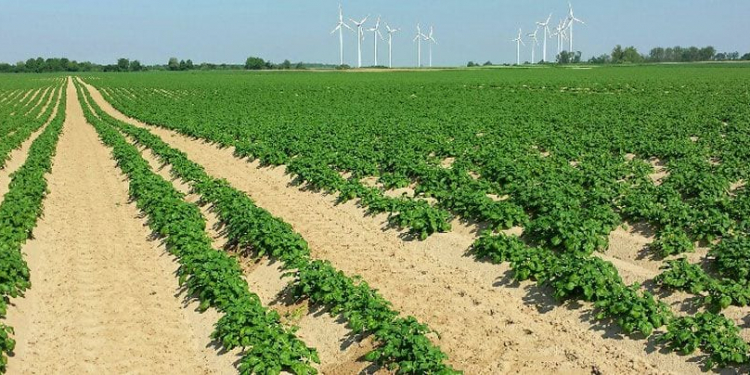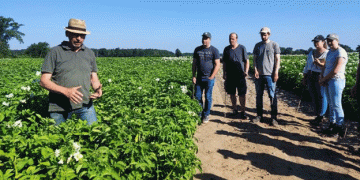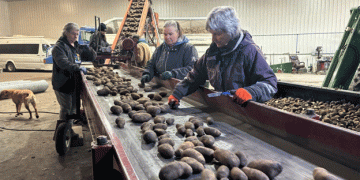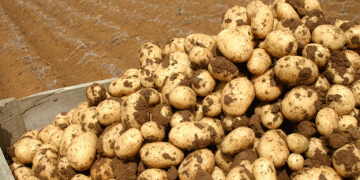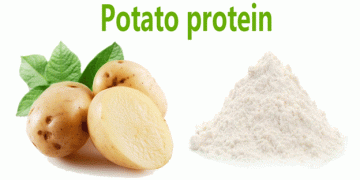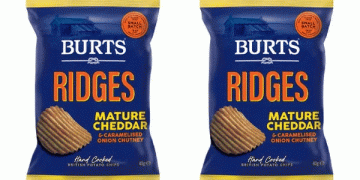As a result of the coronacrisis, Wilhelm Weuthen GmbH, the largest potato trading house in Europe, is not organising a Weuthen Kartoffeltag for the first time in 31 years. However, Ferdi Buffen has traditionally delivered his speech with the market estimate of the 2020 harvest.:
Dear customers, farmers, suppliers of seedlings, exhibitors and other service providers for everything to do with potatoes. We would have loved to greet you personally today on our Potato Day. But like all other major events, the 31st Weuthen Potato Day fell victim to the Corona crisis.
Last year around this time the world was still in its usual order. The potato industry has also been driven by higher, faster and further in the last decade. Growth, especially in the European processing industry, knew no bounds. We have all benefited from this growth and have hit hard ground in the last few months. Nothing has been the same since February and we will probably have to get used to dealing with the virus and living.
What if Corona hadn’t come?
One thing is certain: “We would have a completely different cash market as it is today”. We are in the third year of drought in a row and with normal pre-Corona sales in the processing area we would be concerned about the raw material supply today. But it turned out differently. With the lockdown of the world economy, the potato industry around the refined products, most of which are sold in the catering sector, was pulled away from under its feet.
Nevertheless, I can say today that we had to master the very great challenge of the pandemic together with our customers and farmers and will continue to do so. This is only associated with major financial losses in the entire value chain. The supposed surpluses could be used as alternatives in the starch, flake, granulate, biogas or feed market.
How has the new harvest gone so far?
The market has been divided into two parts since the beginning of the pandemic. In particular, the ware potato market via the food retail and the farm sellers benefited from the hamster purchases. This positive trend is continuing and the freshly prepared, tasty table potatoes are once again more popular with consumers. Chip sales are also good. Due to the lack of major events, trade fairs, travel restrictions and requirements in the catering sector, however, sales of French fries are still well below the previous year’s level. Similar to the US model, the potato industry wanted to limit the potato areas, but the cultivation planning and the delivery of the seed potatoes for this year’s planting were largely complete at the beginning of the pandemic.
Despite all the measures, a slight expansion of cultivation by 2% in the important cultivation regions of Europe could no longer be prevented. It was therefore clear to the French fries growers, at least, that with full cold stores and very long availability of aging stored goods, market access would be delayed and difficult.
When we come to an initial conclusion at the end of August, we can see the following:
– The import season for early potatoes has been handled halfway according to plan.
– The marketing of the early potatoes from German cultivation regions ran until the end of July with satisfactory income. Since every region has been able to supply itself since the beginning of August, there are now early varieties, especially in the Palatinate and Lower Saxony, that are pushing onto the market and some of which have to be temporarily stored. The prices for this are clearly below quotation.
– Chip potatoes have flowed out according to plan so far. The sales in this segment are gratifyingly positive.
– In the processing area, the marketing of the early and subsequent varieties was largely completed at the beginning of September. This also has to do with the fact that the yields in this segment were below average due to frost damage and drought. Nevertheless, free goods could still only be marketed for alternative uses at very low prices.
– The excellent infrastructure of the Rhineland has turned out to be a great competitive advantage this year. On the high-performance sorting systems, we were able to respond to the needs and the
Importing the specification of the works exactly, which has given us an enormous lead. The strategy of serving early fast food needs with pre-sprouted Zorba and Innovator in addition to the high-yield standard varieties has proven to be a recipe for success. Together with the farmers, we have again demonstrated the flexibility, reliability and quality assurance provided by irrigation capacities.
In our opinion, the main harvest is as follows:
Our trial clearings are from all important growing regions. If it looked like a record yield at the beginning of July, the last hot and dry weeks have left their mark. In addition to the extremely dry Rhineland, we also have to think outside the box. In particular on the heavy clay soils in the Netherlands, the potatoes are much more vital and still have growth potential.
Most varieties have a smaller bulbous base and are therefore coarse. The strength values are also good and high. In addition to good yields in the factory, however, this also means a high level of shock sensitivity. Many table potatoes also have a lot of starch stored in them. In addition to the lack of the typical cooking characteristics of the variety, careful harvesting is a major challenge. Since many stocks go into natural ripeness early on, there is an increased risk of animal damage.
It remains to be seen how the potatoes, which have grown under renewed extreme conditions, will be stored accordingly. The elimination of CIPC is another major challenge.
How many potatoes will still grow in the European fields in the coming weeks and, above all, will be available in the required quality, can only be assessed at the end of storage. According to current estimates, the area is partly offset by a mediocre yield. However, Bavaria in particular can expect good harvests and the eastern German states a slightly better harvest than in previous years.
We currently estimate the harvest volume as follows:
– Germany: 10.75 – 11.50 million tons
– EU 4+ GB: 26.00 – 28.00 million tons
Without the Corona crisis and the associated loss of sales in the processing area, the market would be balanced or rather scarce and we would also have an adequate price level and a market for free goods in the processing area. The main harvest and storage has not yet started. But mathematically today we have to live with the bare reality that the supply exceeds the corona-related weaker demand.
Because of the great uncertainty in the global sales markets for French fries, a realistic price forecast is hardly possible. Any price prediction today would be pure speculation. In our opinion, the regional market for table potatoes is balanced. The price level will hopefully hold its own in the double-digit range during the harvest phase. In the course of marketing there will be a greater price difference between premium and standard qualities.
We do not expect any major export impulses in the coming months. The price level for this will be well below the prices of the regional packers, because double-use locations, intermediate stored early varieties and oversizes from planting material production are also pushing into this market.
For free processing potatoes, we only expect demand in alternative uses such as starch, biogas and feed by the end of the year. The price level for this will range between € 1.50 and a maximum of € 3.00 depending on the freight parity with the starch, biogas and cattle farms.
The processors currently produce between 80 and 85% of the previous year’s level and have plenty of contracts for this. By the end of the year you will hardly have any need for acquisitions. Business is burdened by concerns about impending import duties and uncertain sales in the important markets in Asia and South America, where the corona pandemic has not yet peaked. Whether the market will look different again in spring depends largely on the further development of the corona pandemic. Only a nationwide supply of a vaccine will make major events, sporting events, folk festivals, etc. possible again. Therefore, today’s April futures market is currently the only reflection of expectations in spring.
A look ahead:
For the planting in 2021, we expect a good supply of high-quality planting material in the desired sorting. In addition to our tried and tested variety package with robust, high-yielding varieties, we also focus on promising new varieties. Potato breeding is also facing major challenges due to the changed political framework conditions for fertilization and the discontinuation of pesticide approvals.
We will have to position ourselves for the year 2021 according to the changed demand situation and adapt the cultivation areas. In the process, regions remote from the freight and uncompetitive locations are attacked. We, the highly specialized agriculture and the entire potato industry at home and abroad, are facing the expected tough competition and the resulting pressure on prices and margins throughout the value chain. We will have to walk through a deep valley together, but in the medium term the north-western European potato industry with its excellent potato products is and will remain very competitive and will emerge stronger from this crisis.
We will continue to adhere to the basic system of contract production based on contract cultivation, which has been tried and tested for many years.
It remains to be seen to what extent production standstills will be postponed from the end of July to June due to the large increase in costs for germ inhibition. This certainly plays into the cards of our reliable, early, highly specialized farmers with pre-germination options.
The committed team of the Weuthen company and all RWZ potato subsidiaries have proven themselves to be a reliable partner to the agriculture and potato industry in recent months. We will continue to be your safe, reliable and flexible partner in the future.
Stay healthy and we hope to see you all again next year for the 31st Weuthen Potato Day.
Current situation and market estimate of the 2020 harvest.
Best customers, growers, seed suppliers, exhibitors and all other service providers in the potato sector. We would have liked to have welcomed you personally today on our cartel tag. But like all other major events, the 31st Weuthen Kartoffeltag has also fallen victim to the Corona crisis.
Last year, the world was fine as it is. In the last decade, the potato sector has also been driven by higher, faster and on. Growth, particularly in the European manufacturing industry, was without Frontiers. We have all benefited from this growth and, in recent months, we have all reached the lowest point. Since February, nothing is as it was. We’ll probably have to live with it to get used to the virus and deal with it.
What if Corona hadn’t come?
One thing is certain: we would have a very different spot market than there is now! We are now in the third year in a row, droogtejaar, and with a normal pre-treater, sales in the manufacturing sector, we now have to worry about the supply of raw materials.
But things have changed. Thanks to the global economy’s lockdown, the potato industry has lost a lot of ground with the potato processing products, most of which are sold to the catering industry.
However, I can see today that we have had and will continue to face the very great challenge of the pandemic together with our customers and growers. This can only be accompanied by major financial losses throughout the potato chain. In order to obtain the highest possible value from the surpluses, these have been incorporated into alternatives such as starch, flakes, granules, digester and fouragemarkets.
How has the new harvest gone so far?
Since the beginning of the pandemic, the market has been split in two. In particular, the market for table potatoes through retail and farm shops has benefited from HAMSTER behaviour. This positive trend is continuing and the freshly prepared, tasty table potato is again well received by the consumer. The sale of chips is also good. However, due to the lack of major events, fairs, travel restrictions and measures in the catering industry, the sale of fries is still well below last year’s level. The potato industry wanted to limit the potato area, similar to the US example, but the cultivation planning and supply of seed potatoes for this year’s planting were largely completed at the beginning of the pandemic.
Despite all the measures taken, it was no longer possible to prevent a slight 2% increase in cultivation in Europe’s important growing areas. It was therefore clear to the deep-frozen operators that the possibility of marketing their product would be delayed and complicated with full frozen houses and a very long availability of old crops.
When we come to a first conclusion at the end of August, we can say the following::
- The import season for early table potatoes has to some extent gone according to schedule.
- The marketing of early table potatoes from German growing areas has enjoyed a pleasant level of income until the end of July. Since early August each region has been able to supply itself, there are still early varieties, especially in the Palatinate and Lower Saxony, which print on the market and some of which need to be stored temporarily. The prices are well below the quotations.
- Chip potatoes have so far been completed as planned. The turnover in this segment is pleasantly positive.
- The marketing of early and mid – early varieties was largely completed at the beginning of september. This is also due to the fact that yields in this segment were below average due to frost damage and drought. However, free potatoes could only be marketed at very low prices for alternative channels.
. The excellent infrastructure of the Rhineland has proved to be a major competitive advantage this year. On the resilient sorting companies we were able to respond precisely to the needs and specifications of the factories, which gave us a huge lead. The strategy to use the early fast food needs with pre-sprouted Zorba and Innovator with the secure regions has also been a success recipe. We have again demonstrated the flexibility, reliability and quality assurance through the capacity for development in common with the growers.
In our opinion, the main harvest is as follows::
Our sample samples from all major growing areas are not lying about it. The beginning of July seemed to be a record harvest, so the last warm and dry weeks have left their mark. In addition to the extremely dry Rhineland, however, we must also look beyond the horizon. Especially on the heavy clay soils in the Netherlands, the crops are much more vital and still have growth potential.
Most breeds have a lower tuber content and therefore fall out. Starch levels are also good and high. In addition to a good efficiency in the factory, this also means a high resistance. Many table potatoes also have a high starch content. In addition to the lack of typical RASF dependent cooking property due to excessive underwater weight, careful harvesting is a major challenge. As many crops reach natural maturity at an early stage, there is an increased risk of animal damage. It remains to be seen how the quality of the potatoes, which have been grown again under extreme conditions, will be preserved. The removal of CIPC is another major challenge.
How many more potatoes will grow in European fields in the coming weeks, and in particular in the quality required in the current weather conditions, cannot be assessed until the end of the tendering period. According to current estimates, area growth will be partially offset by medium yield. However, Bayern and the East German Länder expect a better harvest than previous years.
We estimate the harvest volume as follows:: - Germany: 10.75-11.50 million tonnes
- EU 4 + GB: 26-28 million tonnes
Without the Corona crisis and The Associated losses of sales in the processing sector, the market would be in balance or shortage of supply and we would also have a pleasant price level and demand for free raw material in the potato processing sector. The main harvest and sizing period has not yet begun. But statistically, today we have to live with the harsh reality, demand will be lower than the supply will be due to the Corona crisis.
Because of the high uncertainty in the world market for fries, a realistic price forecast is hardly possible. Any price speculation today would be pure speculation.
In our opinion, the regional market for table potatoes is in balance. We hope that the price level in the harvesting phase will remain the double digits. During the season there will be a greater price difference between premium and standard quality. We do not expect any major export impulses in the coming months. The price level will be significantly lower than the prices of the regional Packers, because the dual-purpose varieties will also depress the market.
We expect that the demand for free fryer potatoes will be limited to demand in alternatives such as starch, digesters and feed until the end of the year. The price level is between € 1.50 and up to € 3.50, depending on the freight costs to the starch, digester and beef farms. Processors currently produce between 80% and 85% of the previous year’s level and are fully covered by contracts. They will have little need for purchases until the end of the year. Threatening import duties, uncertain sales in key markets such as Asia and South America, where the Corona pandemic has not reached its peak, have a major impact on the sector. Whether the market will change again in the spring will depend largely on the further development of the Corona pandemic. Only a global vaccine makes major events, sports events, festivals, etc. again possible. That is why today’s forward market in april is the only reflection of spring’s expectations at the moment.
A look ahead:
For the planting season 2021 we expect sufficient quality seed in the desired sorting. In addition to our extensively tested variety pack with robust, yield-strong breeds, we also focus on promising new breeds. The potato-processing industry is also facing major challenges as a result of political decisions on the subject of fertilisation and banning plant protection products.
By 2021 we will have to position ourselves in line with the changed demand situation and adjust the areas accordingly. The regions with high transport and non-competitive regions will lag behind. We, the highly specialized agricultural sector and the entire potato industry at home and abroad, are aware that we are going to face heavy competition and the resulting pressure on prices and margins throughout the potato chain. We will have to go through a deep valley together, but in the medium term, the North-West European potato industry, with its excellent potato products, will remain very competitive and will emerge stronger than before from this crisis.
We will continue to adhere to the system of contract cultivation, which has proved itself for many years. It remains to be seen to what extent production stops will be moved from the end of July to June as a result of the large increase in the cost of germination. This will certainly play into the hands of our reliable, early specialized growers with the ability to germinate.
The dedicated team of Weuthen and all RWZ potato daughters have proved themselves in recent months as a reliable partner of the agricultural and potato industries. We will continue to be their safe, reliable and flexible partner in the future.
Stay healthy and hopefully we can all welcome you again next year on the 31st Weuthen Kartoffeltag.
source: https://www.weuthen-gmbh.de/
